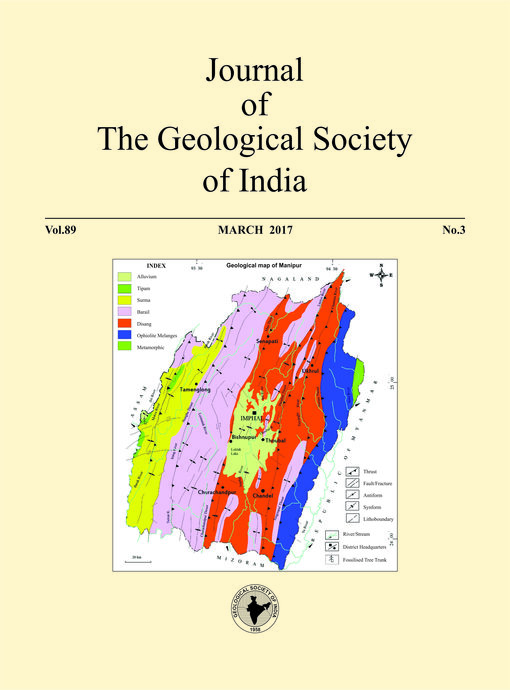Effect of Different Wall Roughness on the Frictional Behavior of Rock Joints
DOI:
https://doi.org/10.1007/s12594-017-0603-1Abstract
Rock discontinuities play a crucial and critical role on the deformational and failure behavior of the rock mass. In most investigations, both the surfaces of the rock joints are considered to have same roughness. But, in nature, the walls of a fresh joint is only expected to be complimentary and to have same roughness. Weathered and water percolating rock joint is most likely to develop different surface roughness on the two opposite walls. So, the shear strength and frictional response behavior derived from the single joint roughness coefficient (JRC) assumption cannot be used in such a condition. To address this shortcoming, we have prepared sandstone blocks with different surface roughness and conducted experiments in a tribometer. The static friction, shear stiffness and coefficient-of-friction of the joint surfaces were calculated and their changes with increasing normal load were noted. One of the major findings of this paper is that, shear strength of the joints may not have a direct correlation with the increasing JRC value of the individual joint walls. Hence, some of the joint walls having higher cumulative JRCs were found to show lower shear strength than those with lowers roughness. This is because, the opposing walls of such joints are not anymore complementary and the frictional resistance is completely controlled by the height and contact area of the asperites.Downloads
Metrics
Issue
Section
Downloads
Published
How to Cite
References
Amadei, B. and Saeb, S. (1990) Constitutive models of rock joints. Proc. Internat. Symp. on rock joints, pp.581–94, Leon, Norway.
Babanouri, N. and Nasab. Karini, S. (2008) Sarcheshmeh pseudowedge failure, a new challenge in expanding western sector of Sarcheshmeh Copper Mine. Proc. 5th Asian Rock Mech. Symp. (ARMS5), pp.559-566, Tehran, Iran.
Bandis, S.C., Lumsden, A.C. and Barton, N. (1983) Fundamentals of rock joint deformation. Internat. Jour. Rock Mechanics and Mining Sci., v.20(6), pp.249-268.
Barton, N. (1976) The shear strength of rock and rock joints. Internat. Jour. Rock Mechanics and Mining Sci., v.13(9), pp.255-279.
Barton, N. and Choubey, V. (1977) The shear strength of rock joints in theory and practice. Rock Mechanics, v.10, pp.1-54.
Bidgoli, M.N. and Jing, L. (2014) Anisotropy pf strngth and deformability of fractured rocks. Jour. Rock Mechanics and Geotechnical Engg., v.6(2), pp.156-164.
DIGHT, P.M. and CHIU, H.K. (1981) Prediction of shear behavior of joints using profiles. Internat. Jour. Rock Mechanics and Mining Sci., v.18, pp.369-386.
Guha Roy, D. and Singh, T.N. (2015) Fluid flow through rough rock fractures: Parametric study. Internat. Jour. Geomechanics doi: 10.1061/ (ASCE)GM.1943-5622.0000522, 04015067.
Guha Roy, D. and Singh, T.N. (2016) Effect of heat treatment and layer orientation on the tensile strength of a crystalline rock under Brazilian test condition. Rock Mechanics and Rock Engg, v.49(5), pp.1663-1677.
Guha Roy, D., Vishal, V. and Singh, T.N. (2016) Effect of carbon dioxide sequestration on the mechanical properties of Deccan basalt. Environ. Earth Sci., v.75(9), pp.1-13. doi: 10.1007/s12665-016-5587-4.
Jain, A., Verma, A.K., Vishal, V. and Singh, T.N. (2013) Numerical simulation of fault reactivation phenomenon. Arabian Jour. Geosciences, v.6(9), pp.3293-3302.
Ladany, B. and Archambault, G. (1970) Simulation of shear behavior of a jointed rockmass. Proc. 11th US Symp. on rock mechanics, pp.105–25, New York.
Lee, H.S., Park, Y.J., Cho, T.F. and You, K.H. (2001) Influence of asperity degradation on the mechanical behavior of rock joints under cyclic shear loading. Internat. Jour. Rock Mechanics and Minining Sci., v.38, pp.967-980.
Maheshwar, S., Verma, A.K., Singh, T.N. and Bajpai, R.K. (2015) Study of thermo-hydro-mechanical processes at a potential site of an Indian nuclear repository. Jour. Earth System Sci., v.124(8), pp.1693-1708.
Patton, F.D. (1966) Multiple modes of shear failure in rock. 31st Internat. Congress on Rock Mechanics, pp.509–513, Lisbon.
Plesha, M.E. (1987) Constitutive models for rock discontinuities with dialatancy and surface degradation. Internat. Jour. Numerical and Analytical Methods in Geomechanics, v.11, pp.345-362.
Ranjith, P.G., Fourar, M., Pong, S.F., Chian, W. and Haque, A. (2004) Characterisation of fractured rocks under uniaxial loading states. Jour. Rock Mechanics and Minining Sci., v.41(1), pp.43-48.
Singh, A.K., Kainthola, A. and Singh, T.N. (2012) Prediction of factor of safety of a slope with an advance friction model. Jour. Rock Mechanics and Minining Sci., v.55, pp.164-167.
Singh, A.K. and Singh, T.N. (2013) Simulation of frictional strength and steady relaxation using the rate and state dependent friction model. Pure and Appld. Geophys., v.170, pp.247–257. doi: 10.1007/s00024-012-0493-5.
Tse, R. and Curden, D.M. (1979) Estimating joint roughness coefficients. Jour. Rock Mechanics and Minining Sci., v.16, pp.303-307.
Verma, A.K., Singh, T.N., Verma, M.K. and Sarkar, K. (2009) Predictions of shear displacement in fully grouted rock bolt. Internat. Jour. Rock Mechanics and Tunneling Tech., v.15(2), pp.117-130.
Vishal, V., Das, R. and Singh, T.N. (2012) Investigating the frictional response of granitic rock surface: an experimental approach. Jour. Geol. Soc. India, v.80, pp.493-498.
Vishal, V., Ranjith, P.G., Pradhan, S.P. and Singh, T.N. (2013) Permeability of sub-critical carbon dioxide in naturally fractured Indian bituminous coal at a range of down-hole stress conditions. Engg. Geol., v.167, pp.148-156.
Vishal, V., Jain, N. and Singh, T.N. (2015) Three dimensional modelling of propagation of hydraulic fractures in shale at different injection pressures. Sustainable Environment Research, v.25(4), pp.217-225
Wu, T.H. and Ali, E.M. (1978) Statistical representation of joint roughness. Internat. Jour. Rock Mechanics and Minining Sci., v.15, pp.59-262.

 Debanjan Guha Roy
Debanjan Guha Roy






